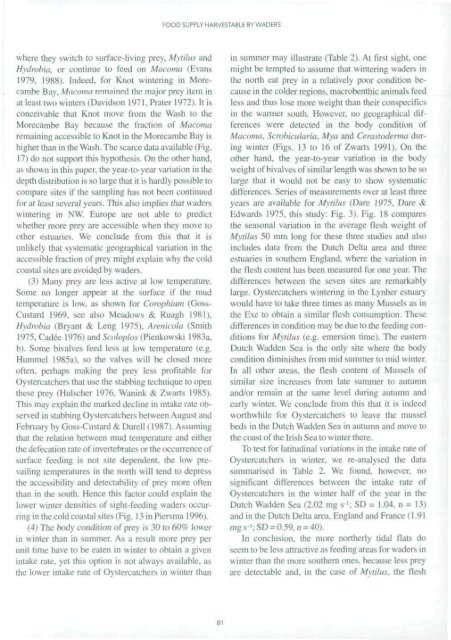waders and their estuarine food supplies - Vlaams Instituut voor de ...
waders and their estuarine food supplies - Vlaams Instituut voor de ...
waders and their estuarine food supplies - Vlaams Instituut voor de ...
Create successful ePaper yourself
Turn your PDF publications into a flip-book with our unique Google optimized e-Paper software.
where they switch to surface-living prey, Mytilus <strong>and</strong><br />
Hydrobia, or continue to feed on Macoma (Evans<br />
1979, 1988). In<strong>de</strong>ed, for Knot wintering in Morecambe<br />
Bay, Macoma remained the major prey item in<br />
at least two winters (Davidson 1971. Prater 1972). It is<br />
conceivable that Knot move from the Wash lo die<br />
Moreeambe Bay because the fraction of Macoma<br />
remaining accessible to Knot in the Moreeambe Bay is<br />
higher than in the Wash. The scarce dala available (Fig.<br />
17) do not support this hypothesis. On the other h<strong>and</strong>.<br />
as show n in ibis paper, the year-to-year variation in the<br />
<strong>de</strong>pth distribution is so large that it is hardly possible to<br />
compare sites if the sampling has not been continued<br />
for at least several years. This also implies that <strong>wa<strong>de</strong>rs</strong><br />
wintering in NW. Europe are not able to predict<br />
whether more prey are accessible when ihey move to<br />
other estuaries. We conclu<strong>de</strong> from this that il is<br />
unlikely that systematic geographical variation in the<br />
accessible fraction of prey might explain why the cold<br />
coastal sites are avoi<strong>de</strong>d by <strong>wa<strong>de</strong>rs</strong>.<br />
(3) Many prey are less active al low temperature.<br />
Some no longer appear at the surface if the mud<br />
temperature is low, as shown for Corophium (Goss-<br />
Custard 1969. sec also Meadows & Kuagh 1981).<br />
Hydrobia (Bryant & Leng 1975). Arenicola (Smith<br />
1975, Ca<strong>de</strong>e 1976) <strong>and</strong> &ofcp/os (Kenkowski 1983a.<br />
b). Some bivalves feed less at low temperature (e.g.<br />
Hummel 1985a). so the valves will be closed more<br />
often, perhaps making the prey less profitable for<br />
Oystercatchers that use the stabbing technique to open<br />
these prey (Hulscher 1976. Wanink & Zwarts 1985).<br />
This may explain the marked <strong>de</strong>cline in intake rate observed<br />
in stabbing Oystercatchers between August <strong>and</strong><br />
February by Goss-Custard & Durell (1987). Assuming<br />
that the relation between mud temperature <strong>and</strong> either<br />
the <strong>de</strong>fecation rate of invertebrates or the occurrence of<br />
surface feeding is not site <strong>de</strong>pen<strong>de</strong>nt, the low prevailing<br />
temperatures in the north will tend to <strong>de</strong>press<br />
the accessibility <strong>and</strong> dclcciability of prey more often<br />
than in the south. Hence this factor could explain the<br />
lower winter <strong>de</strong>nsities of sight-feeding <strong>wa<strong>de</strong>rs</strong> occurring<br />
in the cold coastal sites (Fig. 13 in Piersma 1996).<br />
14) The body condition of prey is 30 to 60% lower<br />
in winter than in summer. As a result more prey per<br />
unit time have to be eaten in winter to obtain a given<br />
intake rate, yet this option is not always available, as<br />
the lower intake rate of Oystercatchers in winter than<br />
FOOD SUPPLY HARVESTABLE BY WADERS<br />
81<br />
in summer may illustrate (Table 2). At first sight, one<br />
might be tempted to assume lhat wintering <strong>wa<strong>de</strong>rs</strong> in<br />
the north eat prey in a relatively poor condition because<br />
in the col<strong>de</strong>r regions, macrobenthic animals feed<br />
less <strong>and</strong> thus lose more weight than <strong>their</strong> conspecilics<br />
in the warmer south. However; no geographical differences<br />
were <strong>de</strong>tected in ihe body condition of<br />
\l,i, nma. Scrobicularia. Mya <strong>and</strong> Cerasto<strong>de</strong>rma during<br />
winter (Figs. 13 to 16 of Zwarts 1991). On the<br />
other h<strong>and</strong>, the year-to-year variation in the body<br />
weight of bivalves Of similar length was shown to be so<br />
large that it would not be easy to show systematic<br />
differences. Series of measurements over at least three<br />
years are available for Mytilus (Dare 1975. Dare &<br />
Edwards 1975. this study: Fig. 3). Fig. 18 compares<br />
the seasonal variation in the average llesh weight of<br />
Mylilus 50 mm long for these three studies <strong>and</strong> also<br />
inclu<strong>de</strong>s data from the Dutch Delta area <strong>and</strong> three<br />
estuaries in southern Engl<strong>and</strong>, where the variation in<br />
the llesh content has been measured for one year. The<br />
differences between the seven sites are remarkably<br />
large. Oystercatchers wintering in the Lynher estuary<br />
would have to take three times as many Mussels as in<br />
the Exe to obtain a similar llesh consumption. These<br />
differences in condition may be due lo the feeding conditions<br />
for Mytilus (e.g. emersion time). The eastern<br />
Dutch Wad<strong>de</strong>n Sea is the only site where the body<br />
condition diminishes from mid summer to mid winter.<br />
In all other areas, the llesh content of Mussels of<br />
similar size increases from late summer to autumn<br />
<strong>and</strong>/or remain at the same level during autumn <strong>and</strong><br />
early winter. We conclu<strong>de</strong> from this that n is in<strong>de</strong>ed<br />
worthwhile for Oystercatchers to leave the mussel<br />
beds in the Dutch Wad<strong>de</strong>n Sea in autumn <strong>and</strong> move to<br />
ihe coast of ihe Irish Sea to winter there.<br />
To test for latitudinal variaiions in the intake rate of<br />
Oystercatchers in winter, we re-analysed the data<br />
summarised in Table 2. We found, however, no<br />
significant differences between ihe intake rate of<br />
Oystercatchers in the winter half of the year in the<br />
Dutch Wad<strong>de</strong>n Sea (2.02 mg s •; SD = 1.04. n = 13)<br />
<strong>and</strong> in the Dutch Delta area. Engl<strong>and</strong> <strong>and</strong> France (1.91<br />
mgs l :SD = 0.59.n=40).<br />
In conclusion, the more northerly tidal fiats do<br />
seem to be less attractive as feeding areas for w a<strong>de</strong>n in<br />
winter than the more southern ones, because less prey<br />
are <strong>de</strong>tectable <strong>and</strong>. in the case of Mytilus. the llesh

















